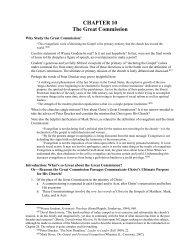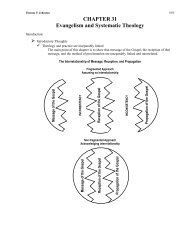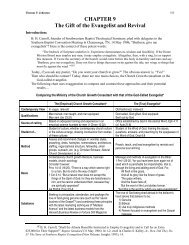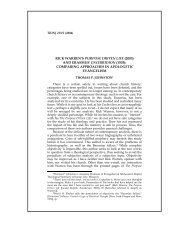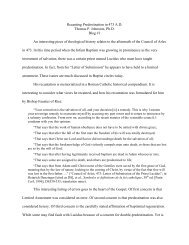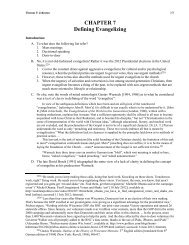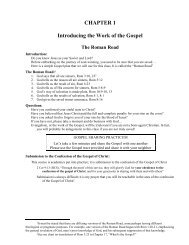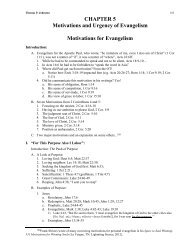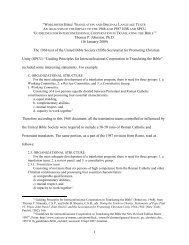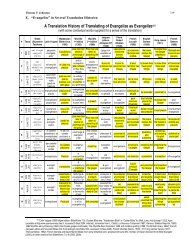Four Categories of Evangelism Programs - Evangelism Unlimited
Four Categories of Evangelism Programs - Evangelism Unlimited
Four Categories of Evangelism Programs - Evangelism Unlimited
Create successful ePaper yourself
Turn your PDF publications into a flip-book with our unique Google optimized e-Paper software.
Thomas P. Johnston 1009<br />
a. Of “Proclamational <strong>Evangelism</strong>” Aldrich wrote:<br />
Although the proclamational approach to evangelism will have validity until Jesus comes, it is<br />
not a means by which the majority <strong>of</strong> Christians will reach their own private world. 1169<br />
b. He drew the following conclusion regarding confrontational/intrusional evangelism: 1170<br />
The vast majority do not become Christians by confrontational, stranger-to-stranger evangelism.<br />
Furthermore, many are being kept from making an effective decision because <strong>of</strong> bad experiences with<br />
a zealous but insensitive witness. 1171<br />
c. While on one hand saying that expectant evangelism was legitimate, on the other hand<br />
Aldrich proclaimed that it was counter-productive, actually hindering “effective decision.”<br />
In two pages <strong>of</strong> his Lifestyle <strong>Evangelism</strong> Aldrich came full circle:<br />
1) Expectant evangelism is valid and legitimate.<br />
2) Expectant evangelism is not practical.<br />
3) Expectant evangelism hinders effective decisions. 1172<br />
d. Following his attack <strong>of</strong> expectant evangelism, Aldrich explained the benefits <strong>of</strong> his<br />
Relational/Incarnational Model using Maslow’s “Hierarchy <strong>of</strong> Needs” to make his point1173 (based on the use <strong>of</strong> George Hunter III). 1174<br />
1) Basis was Maslow’s hierarchy <strong>of</strong> needs: “physiological needs” first , and work up to the<br />
safety/security needs, the love/affection needs, the self-esteem needs, and finally the<br />
self-actualization needs:<br />
1169 Joseph Aldrich, Life-Style <strong>Evangelism</strong>, 78. Aldrich defined “proclamational evangelism” by using the<br />
example <strong>of</strong> the early church: “The early church was planted because <strong>of</strong> the strong proclamational ministries <strong>of</strong> the<br />
apostles. They preached on street corners, in synagogues, and in marketplaces” (ibid.).<br />
1170 Aldrich defined “confrontational/intrusional evangelism” in this way: “The confrontational/intrusional<br />
model is probably the most common one. Generally the ‘target audience’ is a stranger” (ibid.). Thus any nonrelationally-based<br />
one-on-one evangelism can fall into the category <strong>of</strong> “confrontational/intrusional.” However, <strong>of</strong> the<br />
fifty-two personal evangelism conversations in the New Testament, thirty-seven were with complete strangers<br />
(understanding that no one was a stranger to Jesus), five were with previous acquaintances, and the prior relationship <strong>of</strong><br />
ten is unclear from the text (see Thomas P. Johnston, “An Analytical Study <strong>of</strong> Personal <strong>Evangelism</strong> Conversations in<br />
the Gospels and the Book <strong>of</strong> Acts,” Classroom lecture notes, BIB/CHM 230X—Biblical <strong>Evangelism</strong>, Spring 1995,<br />
photocopy], 7). Whitesell cited 35 examples <strong>of</strong> personal evangelism in the ministry <strong>of</strong> Jesus, another 15 examples <strong>of</strong><br />
personal evangelism in the Book <strong>of</strong> Acts, for a total <strong>of</strong> 50 examples (Faris D. Whitesell, Basic New Testament<br />
<strong>Evangelism</strong> [Grand Rapids: Zondervan, 1949], 107-08, 112).<br />
1171 Aldrich, Life-Style <strong>Evangelism</strong>, 79; emphasis mine.<br />
1172 To back up this point, Aldrich quoted James Jauncey, Psychology for Successful <strong>Evangelism</strong> (Chicago:<br />
Moody, 1972), 123: “Just buttonholing a stranger, witnessing to him and pressing for a decision will likely do more<br />
harm than good. Most responsible people react negatively and <strong>of</strong>ten quite violently to this kind <strong>of</strong> assault. It shows a<br />
fundamental lack <strong>of</strong> respect for human dignity and personality” (Aldrich, Life-Style <strong>Evangelism</strong>, 80).<br />
1173 “I have used Maslow’s Hierarchy f needs for years as a teaching tool. I find it helpful in deternining what<br />
level <strong>of</strong> need a person is struggling to satisfy. Motivation to act appears to be directly related to need. If I can link a<br />
solution (the Gospel) to a felt need, I have created a favorable climate to meet that need. … Maslow’s model also lets us<br />
see how important genuine Christian fellowship can be as it is specifically targeted to meet these needs” (ibid., 90, 94).<br />
1174 “George Hunter suggests two further refinements which are full <strong>of</strong> insight. Relatively speaking, those near<br />
the top <strong>of</strong> the hierarchy <strong>of</strong> needs are stronger, more adequate people. Those at the bottom are weaker, more vulnerable<br />
ones” (ibid., 95; notes George Hunter, The Contagious Congregation [Nashville: Abingdon, 1979], 45-47).



